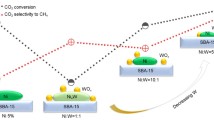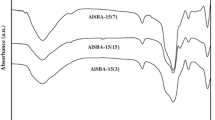Abstract
Ni-doped (CeO2−δ )–YSZ (5 mol% Ni oxide, 10 mol% ceria) mesoarchitectures (MA) with nanocrystalline framework have been synthesized by an original, facile and cheap approach based on Triton X100 nonionic surfactant as template and water as solvent at a strong basic pH value. Following the hydrothermal treatment under autogenous pressure (~18 bars), Ni, Ce, Y, and Zr were well ordered as MA with nanocrystalline framework, assuring thermal stability. A comprehensive investigation of structure, texture, morphology, and surface chemistry was performed by means of a variety of complementary techniques (X-Ray Diffraction, XRD; Raman Spectroscopy, RS; Brunauer—Emmett—Teller, BET; Temperature—Programmed Reduction, TPR; Transmission Electron Microscopy, TEM and DF-STEM; X-ray Photoelectron Spectroscopy, XPS; Catalytic activity and selectivity). N2 sorption measurements highlighted that the mesoporous structure is formed at 600 °C and remains stable at 800 °C. At 900 °C, the MA collapses, favoring the formation of macropores. The XRD and Raman Spectroscopy of all samples showed the presence of a pure, single phase with fluorite-type structure. At 900 °C, an increased tetragonal distortion of the cubic lattice was observed. The surface chemistry probed by XPS exhibits a mixture of oxidation states (Ce3+ + Ce4+) with high percentage of Ce3+ valence state ~35 % and (Ni3+ and Ni2+) oxidation states induced by the thermal treatment. These nanoparticles assembled into MA show high stability and selectivity over time in catalytic partial oxidation of methane (CPOM). These promising performances suggest an interesting prospect for introduction as anode within IT-SOFC assemblies.
Graphical Abstract










Similar content being viewed by others
References
Almar L, Andreu T, Morata A, Torrell M, Yedra L, Estradé S, Peiró F, Tarancon A (2014) High-surface-area ordered mesoporous oxides for continuous operation in high temperature energy applications. J Mater Chem A 2(9):3134–3141. doi:10.1039/C3TA13951D
An CM, Song J-H, Kang I, Sammes N (2010) The effect of porosity gradient in a Nickel/Yttria Stabilized Zirconia anode for an anode-supported planar solid oxide fuel cell. J Power Sources 195(3):821–824. doi:10.1016/j.jpowsour.2009.08.043
Borchert H, Frolova YV, Kaichev VV, Prosvirin IP, Alikina GM, Lukashevich AI, Zaikovskii VI, Moroz EM, Trukhan SN, Ivanov VP (2005) Electronic and chemical properties of nanostructured cerium dioxide doped with praseodymium. J Phys Chem B 109(12):5728–5738
Burroughs P, Hamnett A, Orchard AF, Thornton G (1976) Satellite structure in the X-ray photoelectron spectra of some binary and mixed oxides of lanthanum and cerium. J Chem Soc, Dalton Trans 17:1686–1698. doi:10.1039/DT9760001686
Calderon-Moreno JM, Yoshimura M (2002) Characterization by Raman spectroscopy of solid solutions in the yttria-rich side of the zirconia–yttria system. Solid State Ionics 154–155:125–133. doi:10.1016/S0167-2738(02)00473-3
Chen M, Kim BH, Xu Q, Nam OJ, Ko JH (2008) Synthesis and performances of Ni–SDC cermets for IT-SOFC anode. J Eur Ceram Soc 28(15):2947–2953. doi:10.1016/j.jeurceramsoc.2008.05.009
Dajiang M, Yaoqiang C, Junbo Z, Zhenling W, Di M, Maochu G (2007) Catalytic partial oxidation of methane over Ni/CeO 2-ZrO 2-Al2O3. J Rare Earth 25(3):311–315. doi:10.1016/S1002-0721(07)60428-1
Dilawar N, Mehrotra S, Varandani D, Kumaraswamy B, Haldar S, Bandyopadhyay A (2008) A Raman spectroscopic study of C-type rare earth sesquioxides. Mater Charact 59(4):462–467. doi:10.1016/j.matchar.2007.04.008
Droushiotis N, Doraswami U, Kanawka K, Kelsall G, Li K (2009) Characterization of NiO–yttria stabilised zirconia (YSZ) hollow fibres for use as SOFC anodes. Solid State Ionics 180(17):1091–1099. doi:10.1016/j.ssi.2009.04.004
El Gabaly F, McCarty KF, Bluhm H, McDaniel AH (2013) Oxidation stages of Ni electrodes in solid oxide fuel cell environments. Phys Chem Chem Phys 15(21):8334–8341. doi:10.1039/C3CP50366F
Fairley N (2009) CasaXPS Manual 2.3. 15: spectroscopy. Casa Software Limited, Teignmouth
Garvie R (1978) Stabilization of the tetragonal structure in zirconia microcrystals. J Phys Chem 82(2):218–224. doi:10.1021/j100491a016
Horiuchi H, Schultz AJ, Leung PC, Williams JM (1984) Time-of-flight neutron diffraction study of a single crystal of yttria-stabilized zirconia, Zr (Y) O1. 862, at high temperature and in an applied electrical field. Acta Crystallogr Sect B 40(4):367–372. doi:10.1107/S0108768184002329
Hu C-W, Yao J, Yang H-Q, Chen Y, Tian A-M (1997) On the inhomogeneity of low nickel loading methanation catalyst. J Catal 166(1):1–7. doi:10.1006/jcat.1997.1469
Kim K, Winograd N (1974) X-ray photoelectron spectroscopic studies of nickel-oxygen surfaces using oxygen and argon ion-bombardment. Surf Sci 43(2):625–643. doi:10.1016/0039-6028(74)90281-7
Laha S, Ryoo R (2003) Synthesis of thermally stable mesoporous cerium oxide with nanocrystalline frameworks using mesoporous silica templates. Chem Commun 17:2138–2139. doi:10.1039/B305524H
Ma D, Mei D, Li X, Gong M, Chen Y (2006) Partial oxidation of methane to syngas over monolithic Ni/γ–Al2O3 catalyst—effects of rare earths and other basic promoters. J Rare Earth 24(4):451–455. doi:10.1016/S1002-0721(06)60142-7
Miao Q, Xiong G, Sheng S, Cui W, Xu L, Guo X (1997) Partial oxidation of methane to syngas over nickel-based catalysts modified by alkali metal oxide and rare earth metal oxide. Appl Catal A-Gen 154(1):17–27. doi:10.1016/S0926-860X(96)00377-8
Michel D, Perez y Jorba M, Collongues R (1974) Etude de la transformation ordre-desordre de la structure fluorite a la structure pyrochlore pour des phases (1 − x) ZrO2−x Ln2 O3. Mater Res Bull 9(11):1457–1468. doi:10.1016/0025-5408(74)90092-0
Moon H, Kim SD, Hyun SH, Kim HS (2008) Development of IT-SOFC unit cells with anode-supported thin electrolytes via tape casting and co-firing. Int J Hydrog Energy 33(6):1758–1768. doi:10.1016/j.ijhydene.2007.12.062
Mori H, Wen C-j, Otomo J, Eguchi K, Takahashi H (2003) Investigation of the interaction between NiO and yttria-stabilized zirconia (YSZ) in the NiO/YSZ composite by temperature-programmed reduction technique. Appl Catal A-Gen 245(1):79–85. doi:10.1016/S0926-860X(02)00634-8
Müller G, Vannier R-N, Ringuedé A, Laberty-Robert C, Sanchez C (2013) Nanocrystalline, mesoporous NiO/Ce 0.9 Gd 0.1 O2−δ thin films with tuned microstructures and electrical properties: in situ characterization of electrical responses during the reduction of NiO. J Mater Chem A 1(36):10753–10761. doi:10.1039/C3TA11175J
Otsuka K, Wang Y, Sunada E, Yamanaka I (1998) Direct partial oxidation of methane to synthesis gas by cerium oxide. J Catal 175(2):152–160. doi:10.1006/jcat.1998.1985
Otsuka K, Wang Y, Nakamura M (1999) Direct conversion of methane to synthesis gas through gas–solid reaction using CeO2−ZrO2 solid solution at moderate temperature. Appl Catal A-Gen 183(2):317–324. doi:10.1016/S0926-860X(99)00070-8
Reddy BM, Khan A, Yamada Y, Kobayashi T, Loridant S, Volta J-C (2003) Raman and X-ray photoelectron spectroscopy study of CeO2–ZrO2 and V2O5/CeO2–ZrO2 catalysts. Langmuir 19(7):3025–3030. doi:10.1021/la0208528
Rouquerol J, Rouquerol F, Sing KS (1998) Absorption by powders and porous solids. Academic press, San Diego
Somacescu S, Parvulescu V, Osiceanu P, Calderon-Moreno JM, Su B-L (2011a) Structure and surface chemistry in crystalline mesoporous (CeO2−δ )–YSZ. J Colloid Interf Sci 363(1):165–174. doi:10.1016/j.jcis.2011.06.051
Somacescu S, Parvulescu V, Osiceanu P, Calderon-Moreno JM, Su B-L (2011b) Structure and surface chemistry in crystalline mesoporous (CeO)2-delta–YSZ. J Colloid Interf Sci 363(1):165–174
Somacescu S, Parvulescu V, Calderon-Moreno J, Suh S-H, Osiceanu P, Su B-L (2012) Uniform nanoparticles building Ce1–x Pr × O2−δ mesoarchitectures: structure, morphology, surface chemistry, and catalytic performance. J Nanopart Res 14(6):1–17. doi:10.1007/s11051-012-0885-6
Somacescu S, Osiceanu P, Calderon Moreno JM, Navarrete L, Serra JM (2013a) Mesoporous nanocomposite sensors based on Sn1−x Ce x O2−δ metastable solid solution with high percentage of Ce3+ valence state for selective detection of H2 and CO. Micropor Mesopor Mat 179:78–88. doi:10.1016/j.micromeso.2013.05.011
Somacescu S, Osiceanu P, Calderon Moreno JM, Navarrete L, Serra JM (2013b) Mesoporous nanocomposite sensors based on Sn1−x Ce x O2−δ metastable solid solution with high percentage of Ce3+ valence state for selective detection of H2 and CO. Micropor Mesopor Mat 179:78–88. doi:10.1016/j.micromeso.2013.05.011
Wang W, Su C, Zheng T, Liao M, Shao Z (2012) Nickel zirconia cerate cermet for catalytic partial oxidation of ethanol in a solid oxide fuel cell system. Int J Hydrog Energ 37(10):8603–8612
Zherebetskyy D, Scheele M, Zhang Y, Bronstein N, Thompson C, Britt D, Salmeron M, Alivisatos P, Wang L-W (2014) Hydroxylation of the surface of PbS nanocrystals passivated with oleic acid. Science 344(6190):1380–1384. doi:10.1126/science.1252727
Zhou X, Yan N, Chuang KT, Luo J (2014) Progress in La-doped SrTiO 3 (LST)-based anode materials for solid oxide fuel cells. RSC Adv 4(1):118–131. doi:10.1039/C3RA42666A
Acknowledgments
The authors S. Somacescu, M. Florea, P. Osiceanu, and J.M. Calderon-Moreno are highly grateful for the support given by the Partnership Programme, contract No. 26/2012.
Author information
Authors and Affiliations
Corresponding author
Electronic supplementary material
Below is the link to the electronic supplementary material.
Rights and permissions
About this article
Cite this article
Somacescu, S., Florea, M., Osiceanu, P. et al. Ni-doped (CeO2−δ )–YSZ mesoarchitectured with nanocrystalline framework: the effect of thermal treatment on structure, surface chemistry and catalytic properties in the partial oxidation of methane (CPOM). J Nanopart Res 17, 426 (2015). https://doi.org/10.1007/s11051-015-3206-z
Received:
Accepted:
Published:
DOI: https://doi.org/10.1007/s11051-015-3206-z




